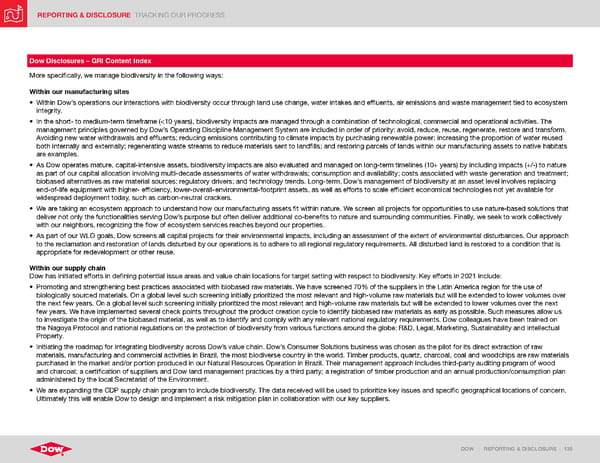REPORTING & DISCLOSURE TRACKING OUR PROGRESS DOW | REPORTING & DISCLOSURE | 135 Dow Disclosures – GRI Content Index More specifically, we manage biodiversity in the following ways: Within our manufacturing sites • Within Dow’s operations our interactions with biodiversity occur through land use change, water intakes and effluents, air emissions and waste management tied to ecosystem integrity. • In the short- to medium-term timeframe (<10 years), biodiversity impacts are managed through a combination of technological, commercial and operational activities. The management principles governed by Dow’s Operating Discipline Management System are included in order of priority: avoid, reduce, reuse, regenerate, restore and transform. Avoiding new water withdrawals and effluents; reducing emissions contributing to climate impacts by purchasing renewable power; increasing the proportion of water reused both internally and externally; regenerating waste streams to reduce materials sent to landfills; and restoring parcels of lands within our manufacturing assets to native habitats are examples. • As Dow operates mature, capital-intensive assets, biodiversity impacts are also evaluated and managed on long-term timelines (10+ years) by including impacts (+/-) to nature as part of our capital allocation involving multi-decade assessments of water withdrawals; consumption and availability; costs associated with waste generation and treatment; biobased alternatives as raw material sources; regulatory drivers; and technology trends. Long-term, Dow’s management of biodiversity at an asset level involves replacing end-of-life equipment with higher- efficiency, lower-overall-environmental-footprint assets, as well as efforts to scale efficient economical technologies not yet available for widespread deployment today, such as carbon-neutral crackers. • We are taking an ecosystem approach to understand how our manufacturing assets fit within nature. We screen all projects for opportunities to use nature-based solutions that deliver not only the functionalities serving Dow’s purpose but often deliver additional co-benefits to nature and surrounding communities. Finally, we seek to work collectively with our neighbors, recognizing the flow of ecosystem services reaches beyond our properties. • As part of our WLO goals, Dow screens all capital projects for their environmental impacts, including an assessment of the extent of environmental disturbances. Our approach to the reclamation and restoration of lands disturbed by our operations is to adhere to all regional regulatory requirements. All disturbed land is restored to a condition that is appropriate for redevelopment or other reuse. Within our supply chain Dow has initiated efforts in defining potential issue areas and value chain locations for target setting with respect to biodiversity. Key efforts in 2021 include: • Promoting and strengthening best practices associated with biobased raw materials. We have screened 70% of the suppliers in the Latin America region for the use of biologically sourced materials. On a global level such screening initially prioritized the most relevant and high-volume raw materials but will be extended to lower volumes over the next few years. On a global level such screening initially prioritized the most relevant and high-volume raw materials but will be extended to lower volumes over the next few years. We have implemented several check points throughout the product creation cycle to identify biobased raw materials as early as possible. Such measures allow us to investigate the origin of the biobased material, as well as to identify and comply with any relevant national regulatory requirements. Dow colleagues have been trained on the Nagoya Protocol and national regulations on the protection of biodiversity from various functions around the globe: R&D, Legal, Marketing, Sustainability and Intellectual Property. • Initiating the roadmap for integrating biodiversity across Dow’s value chain. Dow’s Consumer Solutions business was chosen as the pilot for its direct extraction of raw materials, manufacturing and commercial activities in Brazil, the most biodiverse country in the world. Timber products, quartz, charcoal, coal and woodchips are raw materials purchased in the market and/or portion produced in our Natural Resources Operation in Brazil. Their management approach includes third-party auditing program of wood and charcoal; a certification of suppliers and Dow land management practices by a third party; a registration of timber production and an annual production/consumption plan administered by the local Secretariat of the Environment. • We are expanding the CDP supply chain program to include biodiversity. The data received will be used to prioritize key issues and specific geographical locations of concern. Ultimately this will enable Dow to design and implement a risk mitigation plan in collaboration with our key suppliers.
 ESG Report | Dow Page 134 Page 136
ESG Report | Dow Page 134 Page 136